It’s a rite of fall: the splitting of logs for firewood. It’s arduous, but great exercise, to be sure. It’s also a chance to see a host of fascinating creatures hidden deep in “dead” wood. Just as humans are preparing to hunker down for a long, cold winter, these bugs, worms, and other creepy-crawlies are burrowing into cozy little shelters in the logs you are stacking.
Perhaps the most common log-dwelling critter you will come upon is the carpenter ant. Although homeowners fear these ants for the damage they can wreak on beams and joists, most carpenter ants prefer to stay outside and only invade your home if the wood there is already compromised (i.e. wet and rotten). The vast majority of carpenter ants inhabit dying or felled trees, as well as those nicely stacked rounds awaiting the axe. A neat pile of sawdust is the first tell-tale sign of their nests. The ants aren’t actually eating the wood, they are simply excavating it; sawdust accumulates as they carve brood chambers and other rooms for the colony. Soft, rotting wood is the easiest to carve out. When your axe slices through a nest, hundreds of ants may scatter, frantically carrying off their white, rice-shaped larvae. Evacuating in a panic, they will leave behind deep, irregularly shaped galleries that have served as their home. Carpenter ants are neatniks, meticulous about keeping their rooms free of excess sawdust, frass (insect poop), and dead ants, so the galleries are surprisingly clean for all the activity going on inside them.
The other denizen of logs that homeowners dread is, of course, the termite (the most common is the eastern subterranean termite). You won’t find piles of sawdust outside termite nests, though, because the insects are actively eating the stuff. An average-sized colony of about 60,000 termites can consume up to a quarter-ounce of wood a day, chewing up the equivalent of a one-foot two-by-four in three months; even that seemingly small amount can undermine a beam. However, as voracious as they are, these insects cannot digest wood. Instead, each termite possesses a community of one-celled microbes in its gut. These micro-organisms, called protists, ingest the wood and convert the tough cellulose into sugars and starches that the termites use for energy. In return, the protists enjoy a steady supply of wood and a cozy, safe place to live out their lives. (Really, what could be cozier than the intestine of a termite?)
Both carpenter ants and termites are social insects: members of their colonies share resources, cooperate in the rearing of young year-round, and divide up labor among different castes. Unlike ant colonies, however, which usually consist of a single queen presiding over a few males and many female workers, termite colonies contain reproductive queens, kings, and sexually immature males and females in equal proportion. The white termites you see scrambling around in wood are workers, performing most of the wood harvesting, nest-cleaning, and other domestic chores. A caste of larger, bizarre-looking termites with swollen heads and big mandibles comprises about 5 percent of the colony. These are the soldiers, who defend the nest from marauding intruders such as – yes – carpenter ants. The soldiers look fierce but are remarkably helpless; they are blind and cannot feed themselves, so the workers feed them regurgitated wood pulp. The colony also produces sexually mature, winged termites called alates (from the Latin for wing); these adventurers will disperse from the colony to found new kingdoms. Alates swarm from February to April, depending on their location. With their dark bodies and large wings, they loosely resemble flying carpenter ants, but are easy to distinguish by their lack of a waist (ants are pinched in the middle) and their bead-like antennae (if you feel like getting a really close look). Young termites aren’t pre-programmed at birth; depending on the condition of the colony, larvae can turn into reproductive adults that expand the population, or soldiers, or remain workers until they die.
Many other insects make their homes in the wood of living trees, feeding on the juicy vessels and cambium. Wood-boring beetles come in many shapes and sizes. Some of the most aesthetically pleasing but destructive are the long-horned beetles (in the family Cerambycidae) and the jewel beetles (in the family Buprestidae). The long-horns get their nickname from their antennae, which often exceed the length of their bodies. Some species are spectacularly brightly patterned. Although you may not easily spot these elusive beetles, you can recognize their work by the shape of the exit holes they make when they leave a tree. Cerambycids such as the white-spotted pine sawyer (Monochamus scutellatus) exit as adults through a round hole they gnaw in the bark. If they’ve been feeding in your newly-cut pine logs, you may also recognize their messy piles of sawdust. In contrast, Buprestids such as the 171 species in the borer genus, Agrilus, leave the tree via D-shaped exit holes.
We may think of these wood-munchers as enemies because they can damage living trees, logs, and lumber. Fortunately, the enemy of thine enemy can be a friend, and many insects and other invertebrates hunt these beetles. One predatory boring beetle is the red flat bark beetle (Cuculus clavipes), a cold climate species found from Canada to West Virginia. This bright red beetle has a notably flattened body shape that enables it to search beneath the bark for larvae tucked tightly in their galleries. With strong, club-shaped legs, the beetle clambers through narrow crevices and sneaks up on its prey.
A host of parasitic wasps also lay their eggs in or on woodboring larvae. Many species in the ichneumonid family have very long ovipositors, which they thread through bark to reach a larval chamber. The wasp stings the larva temporarily, stunning it while the wasp deposits one or more eggs. Her eggs then hatch into wasp larvae, which feed on the bodily juices of the hapless beetle while both predator and prey mature to adulthood; one final sting finally fells the beetle, and the wasp emerges from the wood. The adult wasps forage for flower nectar, so one way to encourage their presence is to plant a diverse garden; plants in the carrot and mustard families are particularly attractive food sources to both wasps and humans, and their standing dead stalks provide a good overwintering habitat.
Although most of the 5,000 species of ichneumonid wasps in North America are tiny (less than a quarter of an inch long), four particularly impressive species, the giant ichneumons (in the genus Megarhyssa, meaning “big tail”) attain total body lengths of four inches, of which half is the ovipositor. If you spot one of these ungainly wasps in their bouncing flight, don’t run away screaming; it is not aiming a stinger at you, it’s hunting in your firewood for its favorite prey, another wood-borer called a horntail. A horntail is another kind of wasp, distinguished by its stocky body (without the characteristically pinched wasp waist) and the two “horntail” projections from the back end. Their larvae eat wood, but typically only infest already stressed trees. When a giant ichneumon senses the presence of a horntail deep in a log, it goes through an extraordinary gymnastic routine. On tip-toe it positions its flexible stylus over the wood, then actively pumps a secretion through the stylus to soften the wood as it drills toward its unsuspecting prey.
Next on the list of log inhabitants are the Myriapoda (from the Latin myria, for ten-thousand and the Greek pod, for feet). These creatures include the millipedes and centipedes. Worldwide, there are over 13,000 species in this group, which has evolved on Earth for more than 400 million years. Centipedes are only occasionally found in wood; more often, these predators patrol under the bark and in the damp soil under a log pile, hunting for insects and other prey, which they sting with their fearsome poison glands. Millipedes, on the other hand, are peaceable vegetarians that graze on decaying wood and leaf litter. Although they cannot inflict a painful welt like centipedes, some millipedes have defensive stink glands or emit a stress chemical that can stain human skin. Contrary to their name, millipedes don’t have a thousand feet (the world record is 376 pairs). Rather, they possess two pairs of legs for each of their many body segments (centipedes have only one pair per segment), and the coordinated movement of all those legs gives them an undulating gait as they move across the log’s surface.
Two millipedes are especially common in the Northeast. The pink-footed millipede, Narceus americanus, has shiny black segments, about 180 tiny red legs, and a pink underbelly. It curls up into a tight ball when handled, protecting its soft underbelly with its tough exoskeleton; mother millipedes also curl up around their eggs until hatching time. These millipedes normally weigh in at about one-tenth of an ounce, but can grow up to four inches long, going through many molts as they age and grow; some may live a decade or more. They often use logs as shelter in which to overwinter or to molt, burrowing into the wood and sealing the entrance behind them with wood they have chewed up.
The flat-backed millipede, Polydesmus angustus, is another species that lurks under bark. A bit less than an inch long, fullgrown adults have up to twenty body segments. However, they are not very long-lived, and their lifespan is set by the date on which they are born. (I wonder what their horoscopes say?) Individuals born between May and August (Taurus, Gemini, Cancer, and early Leos) only live one year, whereas those born from August to October (late Leos, Virgos, and Libras) overwinter and live up to two years. This species has been introduced to North America from Europe, where it is a common and important member of the forest ecosystem, processing wood into soil.
When you bring that axe down, you’ll also likely stir up some isopods: the sow bugs and pill bugs (also known as roly-polies). These small, gray creatures have many body segments and legs, but they are crustaceans – more closely related to crabs and lobsters than to centipedes and millipedes. Like their aquatic cousins, isopods need constant moisture and thus like to burrow deep into moist wood. In her nest chamber, a female isopod incubates her fertilized eggs in a pouch until they hatch, much like a mother kangaroo.
We’ve focused mostly on the invertebrates that will scurry about when you slice open a log, but there are many more animals – from spiders to skunks to turkeys – that enjoy hanging out around your woodpile, hunting for the spineless small-fry. And let’s not forget the colorful constellation of woodpeckers and sapsuckers, from the diminutive downy woodpecker to the giant, raucous pileated, which use their sharp bills to forage for living ants, termites, beetle larvae, and other insects in trees and logs. These birds don’t actually have to bang on trees to dig for prey; when they are loudly bonking they are using the resonant, insect-dug hollows to send signals to other birds, perhaps reinforcing territories or inviting them to the smorgasbord.
Dead and dying trees support an entire, elaborate food web – it’s on display now at your firewood landing. When you next get out to whack some logs, take some time to appreciate this wonderful world in wood.


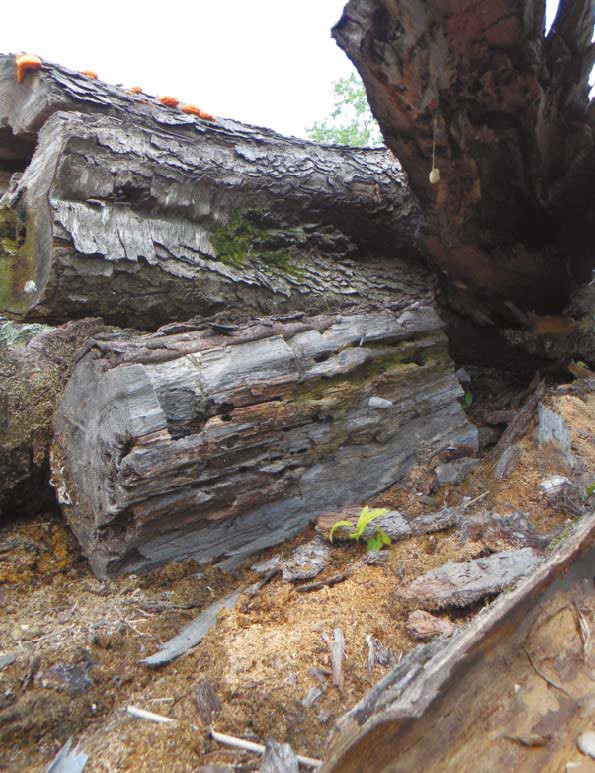
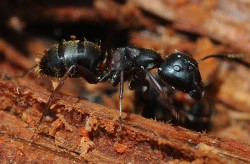
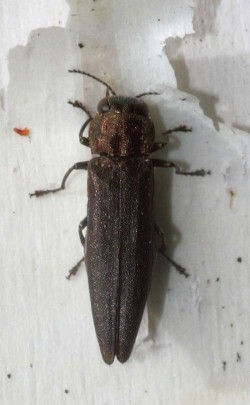
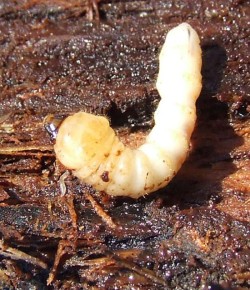
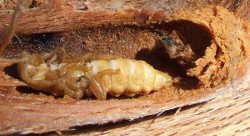
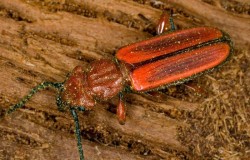
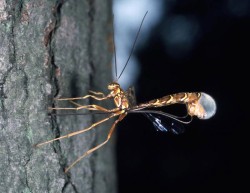
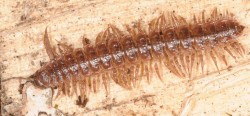
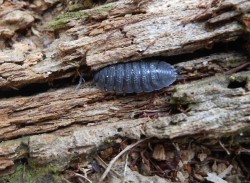
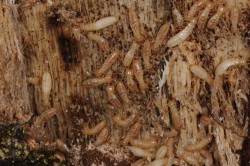
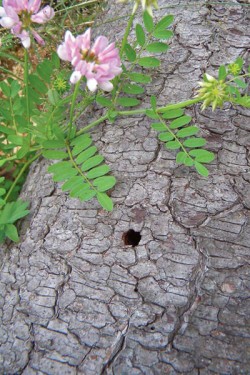
Discussion *